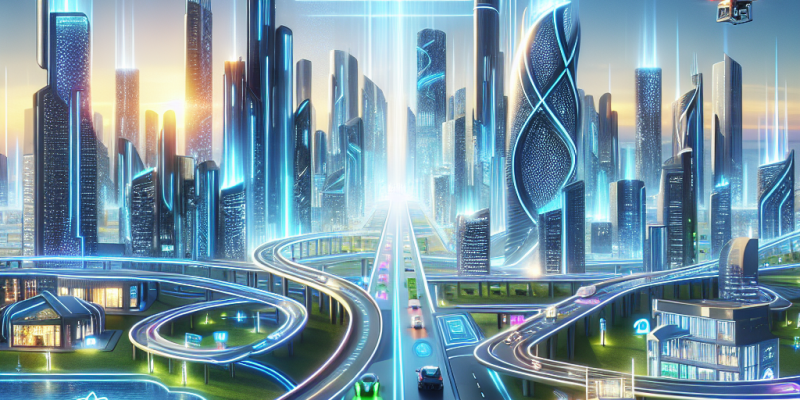AI and the Evolution of Smart Cities: Designing Urban Life in 2024

AI and the Evolution of Smart Cities: Designing Urban Life in 2024
As we navigate through the complexities of urban living, the role of artificial intelligence (AI) in shaping smart cities has become increasingly paramount. By 2024, the integration of AI into urban planning, management, and daily life is transforming the way we interact with our environments. From traffic systems to public safety and energy consumption, AI’s capabilities are fundamentally redesigning urban life, making cities more efficient, sustainable, and user-friendly.
The Rise of Smart Cities
Smart cities leverage digital technology and data-centric approaches to enhance the quality of life for residents, improve city services, and foster sustainable development. The journey towards smart cities began in the early 2000s, but technological advancements in AI, the Internet of Things (IoT), and big data analytics have given it new momentum. By 2024, the definition of smart cities has expanded to incorporate not only technology but also social and environmental considerations.
AI-Powered Urban Management
At the heart of the smart city revolution is AI, which processes enormous amounts of data generated from city infrastructure and residents’ interactions. These data streams are analyzed to identify patterns, predict outcomes, and optimize city operations.
-
Traffic Management: AI algorithms are revolutionizing the way cities manage traffic. Real-time data from vehicle sensors, GPS, and public transport systems can be utilized to dynamically adjust traffic signals, reduce congestion, and improve commuting times. AI-driven platforms can even facilitate smart parking solutions, guiding drivers to available spaces and helping to lower emissions.
-
Public Safety: In the realm of security, AI is enhancing public safety measures. Surveillance systems equipped with smart facial recognition and behavior analysis software support law enforcement without infringing on civil liberties. Predictive policing models use historical crime data to allocate resources efficiently, effectively reducing crime rates.
- Waste Management: Smart waste management systems harness AI to optimize collection routes and schedules based on real-time data about waste levels. This not only reduces operational costs but also minimizes environmental impact by lowering emissions associated with waste collection vehicles.
Enhancing Citizen Engagement
AI and smart city technology also aim to improve citizen engagement. As cities evolve, maintaining an open dialogue with residents becomes vital.
-
Feedback Mechanisms: AI-driven platforms allow residents to provide feedback on city services through mobile applications. This responsive communication enables city officials to make informed decisions based on community needs and issues.
-
Personalized Services: AI enhances the personalization of services by analyzing user interactions and preferences. Applications can now tailor city services, whether it’s offering public transport options that align with a user’s schedule or providing updates on local events that match their interests.
- Participatory Governance: Many cities are deploying AI tools to foster participatory governance. Platforms that utilize AI can analyze public sentiment and encourage citizen feedback on urban projects, ensuring that community voices are considered in the planning process.
Sustainability through AI
Sustainable urban development is critical for addressing the environmental challenges that cities face today, and AI is playing a pivotal role in achieving these goals.
-
Energy Efficiency: AI systems optimize energy consumption in buildings by analyzing usage patterns and implementing smart grids that adjust supply based on demand. By integrating renewable energy sources, such as solar or wind, smooth transitions can be made to minimize carbon footprints.
-
Water Management: Smart water management technology uses AI to detect leaks and forecast water demand, ensuring the efficient distribution and usage of water resources—a crucial factor in urban sustainability, especially in areas facing water scarcity.
- Urban Agriculture: AI is enabling the rise of urban agriculture by optimizing growing conditions within smart vertical farms. Such innovations not only contribute to local food security but are also instrumental in reducing the carbon emissions associated with food transportation.
Challenges and Considerations
Despite the potential benefits of AI in smart cities, several challenges and concerns must be addressed. These include data privacy issues, the digital divide, and the need for robust cybersecurity measures. Additionally, as cities become increasingly reliant on technology, the risk of systemic failures or inequities in service access is a pressing concern.
Looking Ahead: The Future of Urban Living
As we move further into 2024, the evolution of smart cities powered by AI is just beginning. The ongoing development of AI technologies offers the promise of more integrated, resilient, and adaptive urban environments. By balancing technological advancement with ethical considerations and inclusive design, the cities of the future will not only be smarter but will also reflect the diverse needs and aspirations of their residents.
Embracing AI-driven innovations in urban life can help pave the way for sustainable, equitable, and thriving communities that are prepared to face the challenges of tomorrow. In this vision, AI is not simply a tool but a catalyst for reimagining how we experience and interact with our urban landscapes.














